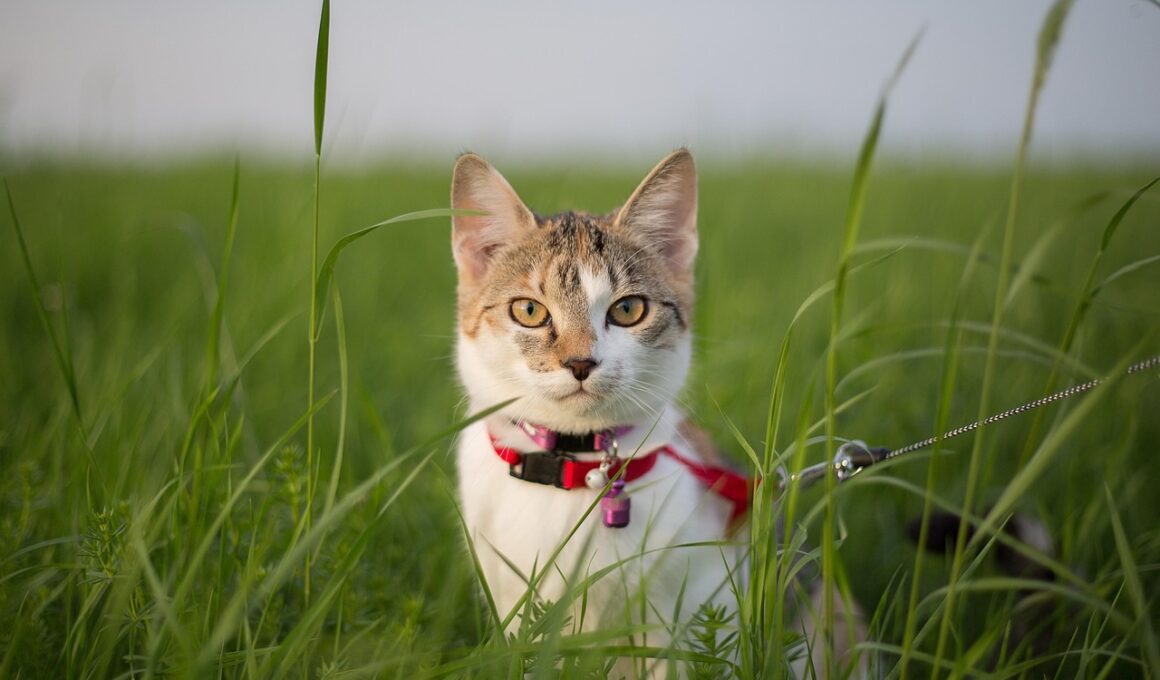Best Leash Lengths for Cat Training and Walking
When training your cat, selecting the right leash length is crucial. Cats possess a natural curiosity and desire for exploration. A leash that is too short may restrict their movement and limit their experience in the world. However, one that is excessively long can lead to tangling or loss of control. In general, a leash length between six to eight feet is considered optimal for most cats, providing a balance of freedom and safety. This length allows them to explore while still being close enough for you to maintain control. Choosing the right leash material can also influence how it performs during use. Opt for lightweight options, such as nylon or cotton, which are easy to handle. They’re less likely to snag on obstacles or irritate your cat’s skin. Additionally, reflective materials can enhance visibility during evening hours. While selecting a leash for cat training, also remember to consider their harness. The harness should evenly distribute pressure to avoid injury. Take time to assess different leash features such as handles or clips, ensuring a secure fit. Always introduce your cat to the leash gradually to create positive associations with the experience.
One key factor to consider when discussing lengths is how your environment can influence your choice. If you live in an area with wide open spaces, a longer leash might be appropriate. However, in busy areas, a shorter leash offers greater control. Keep in mind that cats have a tendency to wander off, necessitating a habitual confining of exploration. In urban settings, a four to six-foot leash can provide a balance between giving your cat freedom and maintaining necessary restraint. It’s wise to avoid letting your cat roam unsupervised. This can lead them to dangerous situations with cars or other animals. Training them to walk on a leash in a bustling park can also help them acclimatize to the sights and sounds of the outdoors while ensuring safety remains paramount. Gradually increase the length of your walks as your cat becomes more comfortable. Using positive reinforcement methods, such as treats, during training can be effective in solidifying good behavior. Choose rewards that keep your cat motivated and eager to engage with their walking routine. Over time, your cat will not only learn to walk well on the leash but will also become more accustomed to outdoor experiences.
Types of Leashes and Their Benefits
The market offers various types of leashes, each with distinct benefits. Standard leashes are typically flat and made from durable materials, providing straightforward functionality. These leashes come in varying lengths but primarily range from four to eight feet long. A retractable leash is another option that allows for adjustable length control, permitting your cat to roam further and still return to you with ease. However, caution is advised as these leashes can be cumbersome in busy environments. In contrast, a training leash is usually thicker and potentially shorter, designed to ensure maximum control during training sessions. When considering a leash, also think about the attachment mechanism. Some leashes use a carabiner clip, while others have snap hooks. Each has its advantages. Carabiners can offer extra security against accidental disconnection. Ultimately, the choice often comes down to personal preference, the specific needs of your cat, and your training goals. Additionally, compatibility with harnesses is vital, ensuring a seamless and safe experience. The leash should complement your cat’s harness while providing reliable hold and comfort.
Another important consideration in leash length and type is the size and breed of your cat. Larger, more energetic breeds, such as Maine Coons, may require sturdier leashes capable of withstanding their strength. Alternatively, smaller breeds, like Abyssinians, might be more suited to delicate and lightweight options. Regular evaluation of your cat’s behavior during walks will also inform your preference for leash length. If your kitty frequently strains against the leash, a shorter length might be more beneficial. Alternatively, cats that seem relaxed may enjoy longer lengths. It is also essential to introduce the selected leash gradually. You can do this by allowing your cat to wear it in the house before venturing outdoors. This technique helps them get accustomed to the feel and concept of walking with a leash. Gradually extending leash training time, starting from a few minutes and increasing as they acclimate will help adapt them to various conditions. Keeping sessions short can make training less stressful for your cat and provide a better experience overall. Be patient and ensure consistent positive reinforcement to achieve the best results during the training process.
Essential Traits of a Cat Training Leash
For effective cat training, certain traits should guide your leash choice. Comfort is paramount; the leash should feel good in your hands. An ergonomic design can reduce strain during prolonged use. Look for padded grips or options featuring a smooth texture, ensuring a comfortable hold. Durability is equally important. A sturdy leash can withstand daily wear and tear, especially when training an energetic or curious cat. Additionally, weather-resistant materials may prolong the life of the leash by preventing damage from rain or other elements. Visibility is another critical factor, particularly in low-light situations. Opt for leashes with reflective strips or bright colors. These characteristics not only promote safety but also enhance visibility during training sessions. Another consideration is the ease of cleaning, as cats can become dirty after outdoor adventures. Choose materials that can be easily wiped down or are machine washable. Familiarization with your cat’s behavior during training will also underscore your leash selection. As they become more comfortable, you may find switching between lengths opens up new walking opportunities.
During the training process, monitoring your cat’s comfort with the leash is crucial. Their body language will provide insight into whether the chosen length is agreeable. Signs of discomfort, such as constant pulling or attempted escape from the harness, indicate that you may need to reassess your choice. In contrast, if they show signs of curiosity, such as exploring their environment without fear, that’s a good indication you are on the right path. As with anything related to training, consistency is an essential ingredient. Establishing a routine helps your cat develop a better understanding of what you expect during leash walks. Regularly practicing with short sessions enables a better foundation for more extended walks. Maintaining a sense of adventure during these training sessions can also be incredibly beneficial. Try incorporating different environments, objects, or even other cats as motivation during these walks. Each successful outing builds positive experiences, reinforcing their willingness to walk calmly. Over time, this consistent practice will lead to improved behavior and a well-trained cat during leash walks, ensuring that both you and your feline companion enjoy your outdoor time together.
Conclusion: Making the Best Choice
In conclusion, making an informed choice regarding leash lengths for cat training and walking enhances both safety and enjoyment experiences for your feline friend. Assessing your cat’s individual behaviors and needs along with your environment can guide your decision. Combining a properly chosen leash with an appropriate harness will allow exploration without compromising security. Keep experimenting with different lengths and styles until you find the perfect balance. Adaptability to their evolving needs may open up various outdoor adventure possibilities. When embarking on outdoor walking experiences, use patience, and offer plenty of praise throughout the training process. Paying attention to your cat’s cues promotes a smoother transition to leash walking. Each positive experience contributes to their confidence. Remember that every cat is unique, and ultimately, your best choice will reflect your cat’s personality and proclivities. Seek recommendations when needed, and don’t hesitate to reach out to fellow cat owners or trainers for advice. Building a bond through these shared outdoor experiences enriches the relationship you have with your furry friend. Embrace this journey together!
To enhance your cat training experience further, owning specialized accessories can prove beneficial. For instance, additional collars with identification tags can improve safety during walks. Always ensure that their harness fits securely to avoid slips during outdoor adventures. Furthermore, consider investing in high-quality treats specifically designed for training sessions. These help incentivize your cat while rewarding good behaviors during walks. When selecting collars, remember that they should be comfortable and not overly constrictive. You can also look into visibility-enhancing accessories such as light-up collars or reflective harnesses for evening strolls. Lastly, the right cat toy can also be integrated into your cat’s walking routine, providing extra motivation throughout your adventures. Toys can facilitate engaging interactions and help teach your cat to associate outdoor activities with fun. By enhancing your training setup with accessories, you foster a more enjoyable and productive walking experience for both you and your cat, laying the groundwork for continued success during your outings together. Be patient and understanding, acknowledging that every positive step contributes to their overall training journey.


